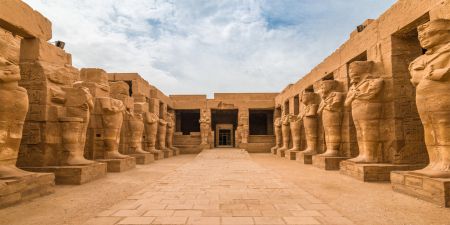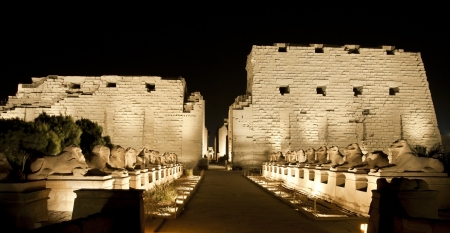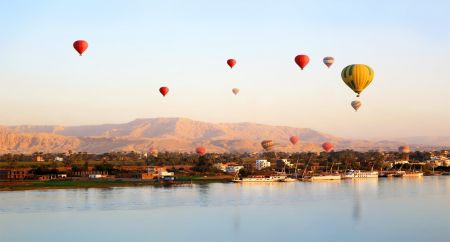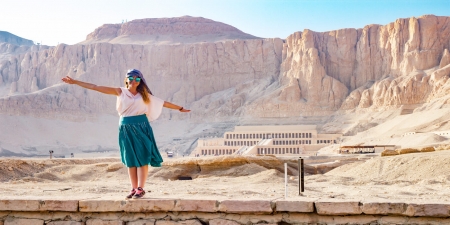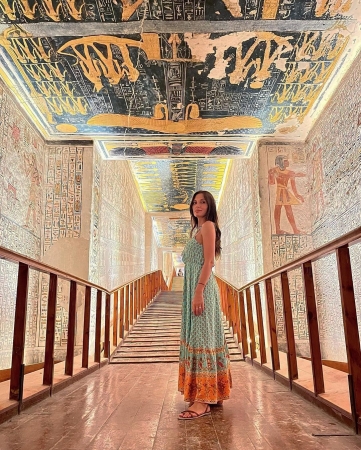Today relatively little remains of what is thought to have once been the most impressive temple complex on the West Bank of the Nile. Several clusters of pillars and a few damaged statues stand among a large field of ridges, holes, broken foundations, and pieces of statuary that mark out where the rest of the complex once stood. The reputation of this site is now tied more to the reputation of the man that commissioned it, rather than the appearance of its ruins.
Ramesses II is the name most often heard in association with many of the monuments around Luxor and further south. He was a prolific builder and also had a habit of repurposing existing monuments to add to his reputation.
He was the greatest conqueror in the history of Ancient Egypt, ruling for 67 years during the New Kingdom (1279—1213 BC) and extending the range of his kingdom into new frontiers in the south, west, and north in Syria.
This temple was dedicated to him and a testament to his power and influence and it was meant to be the greatest of all monuments.
Plundering by subsequent pharaohs, who could no afford to quarry their own stones, natural disasters, and finally this sites use as a church by early
Egyptian Christians have all taken a toll on this once great structure, but even among the scattered ruins evidence of its greatness still persists.
There are the remains of a toppled colossus of Ramesses II that is estimated to have stood over six stories tall, the largest freestanding sculpture ever in Egypt and one of the largest ever attempted anywhere in the world.The decoration of the remaining columns in the hypostyle hall is also impressive, showing the fine craftsmanship with defined the Ramesseum’s construction.
Though relatively little remains, the Ramesseum is still an exciting visit, especially for those with a particular interest in the life of Ramesses II,
the greatestof the pharaohs. Its layout was the inspiration for the much better preserved temple complex at Medinat Habu, constructed by Ramesses III.
A visit there before arriving at the Ramesseum will give you a better impression of how this temples was meant to appear.
Customize Your Dream Vacation!
Get in touch with our local experts for an unforgettable journey.
Plan Your TripEgypt Pyramids
- Dahshur Pyramids | Egypt Pyramids
- How Were the Pyramids Built?
- The Bent Pyramid at Dahshur
- Khafre Pyramid (Pyramid of Chefren)
- Pyramid of Khufu (Cheops Pyramid)
- Pyramid of Menkaure (Mykerinus Pyramid)
- Djoser Step Pyramid at Saqqara
- Giza Necropolis
- The City of Memphis, Egypt
- Saqqara Step Pyramid Egypt
- The Red Pyramid at Dahshur
ِAncient Egyptian History
- The Middle Kingdom of Ancient Egypt
- Alexander the Great | Egypt History
- Queen Hatshepsut
- King Tutankhamun Facts
- Salah Al-Din Al-Ayyubi
- King Ramses II: Facts, Accomplishments, Life and Death
- Sultan Mohammad Ali
- Amr Ibn Al-Aas
- The Old Kingdom of Ancient Egypt
- The New Kingdom of Ancient Egypt
- Greco-Roman Period
- Islamic Egypt
- Mamluk in Egypt & Ottomans History
- Egypt in the Modern Era
- Behind the Throne: Exploring the Life and Reign of Queen Cleopatra of Egypt
Cairo Attractions
- Al Aqmar Mosque in El Muizz Street
- Sultan Al Mansur Qalawun Mosque
- Al Azhar Mosque
- Mosque of Amr ibn al-As: Egypt’s Oldest Mosque and a Living Chronicle of Faith
- Bab Zuweila
- Museum of Islamic Art
- Mosque and Madrasa of Sultan Hassan
- Ahmed Ibn Tulun Mosque
- Bayt Al Suhaymi in Cairo
- Cairo Opera House
- The Coptic Museum in Cairo
- The Egyptian Museum in Cairo
- El Ghorya | Attractions in Cairo Egypt
- Ben Ezra Synagogue | Coptic Cairo
- Khan El Khalili Bazaar
- Old Cairo and Coptic Cairo
- Salah El Din Citadel in Cairo | Egypt
- The Hanging Church | Coptic Cairo
- Al-Muizz Al-Deen Allah Street
- Downtown Cairo
- Zamalek / Gezira
- Islamic Cairo
- Souk Al Khayamiya | Tentmakers Bazaar
Alexandria Attractions
- City of Alexandria
- El Ain El Sokhna | Red Sea Egypt
- El Sharkia Governorate History | Egypt Cities
- The Faiyum Travel Guide | Egypt
- Port Said Travel guide | Egypt
- Marsa Alam Information
- Aswan High Dam | The High Dam of Egypt
- Qaitbay Citadel in Alexandria
- Pompey's Pillar in Alexandria
- Why El Alamein Egypt Became World War II's Most Important Battlefield
- Alexandria Egypt | Pearl of the Mediterranean
- Alexandria Library Egypt | Bibliotheca Alexandria
- Things to See in Alexandria
- Cairo Travel information | Cairo Egypt
- The Catacombs of Kom el-Shuqafa
- Greco-Roman Museum
- Lighthouse of Alexandria
- Luxor Travel Guide | Luxor City | Egypt
- Montazah Park Alexandria
- Red Sea Egypt | Red Sea Travel Guide
- The Western Desert of Egypt | Egypt Oases
Luxor Attractions
Aswan Attractions
Nile Valley
Red Sea and Sinai
Ports of Call
Egyptian Culture and Travel Info
See the most famous sites around Luxor on both sides of the river in one day. Visit Karnak Temple and Luxor Temple on the East bank and then see the Valley of the Kings and Hatshepsut Temple on the West Bank.
Enjoy Luxor Tours Watching Karnak Temple Sound and Light Show on the east bank illuminated at night with an audio-visual show that will explain how the temple was built and what life was like in Ancient Egypt.
Enjoy Cairo to Luxor Day Trip Visiting: Karnak Temple on the East bank and see the Valley of the Kings and Hatshepsut Temple on the West bank, Memphis Tours representative will guide you the whole day.
Do it all in one trip. Start in Cairo, then travel by flight to Aswan and embark on your Nile Cruise and explore the majestic attractions of Egypt between Aswan and Luxor. End your tour with a relaxing time on Hurghada beaches.
Plan Your Trip!
You Might Also Like
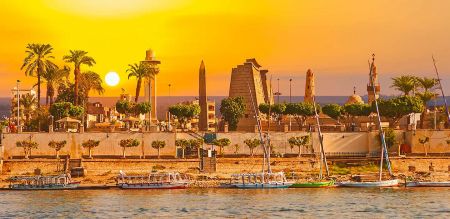
Know more Information about Luxor Egypt and Luxor travel tips. Travel guide to Luxor, Egypt. About Luxor Temples, Karnak Temples, Valley of the kings and more!

Located on the east bank of the Nile, Karnak Temple Complex consists of a number of temples. Its name was given as in Arabic Karnak means fortified village.
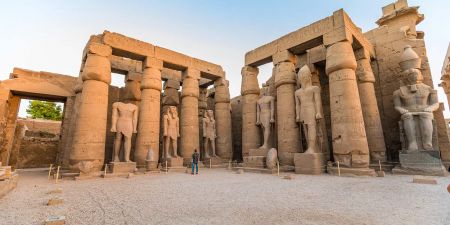
Your complete guide to Luxor Temple in Luxor, Egypt. Discover history, key attractions, and expert sightseeing tips for travelers.

Your guide to the Valley of the Kings—best tombs, history, and insider facts. Get the knowledge you need and start planning your trip today.
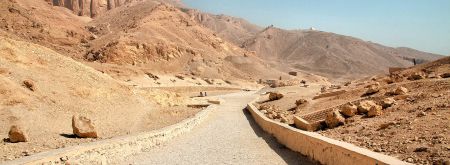
Step into history at the Valley of the Queens, Luxor. Explore royal tombs, ancient artifacts, and fascinating facts about this legendary site.
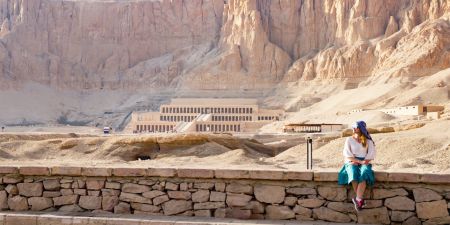
Hatshepsut temple is a reflection of the mortuary temple of Mentuhotep II and was constructed alongside that 11th dynasty structure. Know more information about Temple of Hatshepsut!
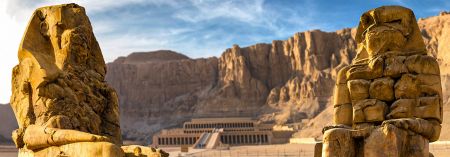
Colossi of Memnon, survived for 3,400 years & known as an acoustic wonder of the ancient world, is the first monument tourists see in the west bank. They are famous for the mysterious sound emitted at sunrise.
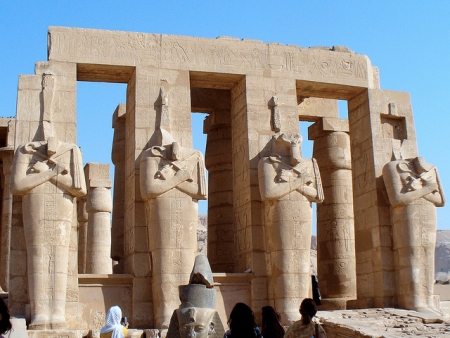
Today relatively little remains of what is thought to have once been the most impressive temple complex on the West Bank of the Nile. Several clusters of pillars and a few damaged statues.
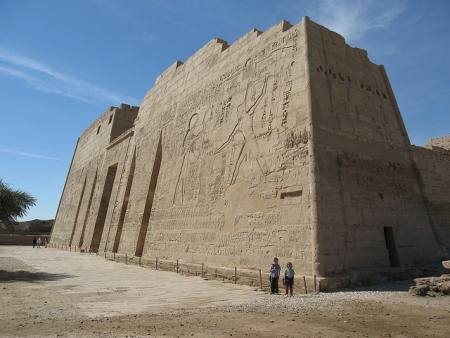
While it is not among the most well traveled sites on the West Bank, Medinat Habu is considered by many visitors to be among the most impressive sights they see in Luxor.
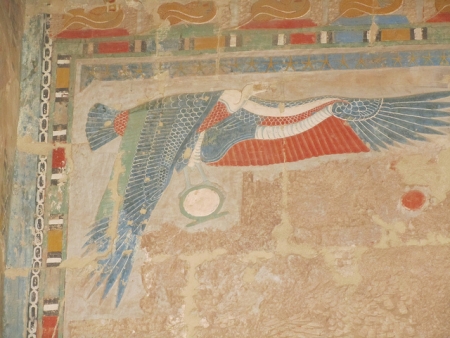
Almost all of what we see today of Ancient Egypt is exclusively dedicated to the pharaonic royalty. The monumental building projects that the kings of Egypt commissioned have stood the test of time much better.

Almost of what we see today of Ancient Egypt is exclusively dedicated to the pharaonic royalty. The monumental building projects that the kings of Egypt commissioned throughout the history.


